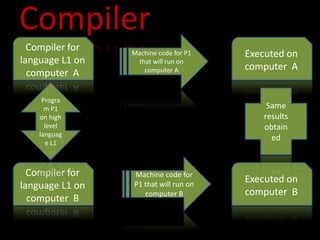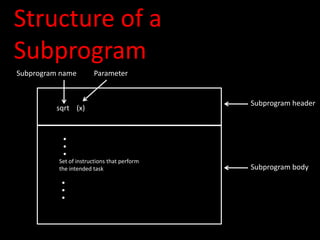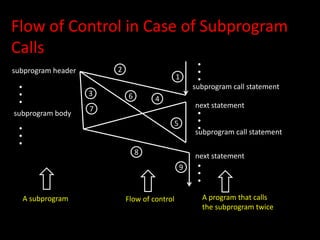High Level Language (HLL)
- 2. MULTIFORM 191 FARDIN SAHARIAR SHUVO 182 RABBI-AL-SIFAT 110 MD.NAYMUR RAHMAN SHAKIL 179 NAZMUL HAQUE 174 MD.NOMAN SARKER 116 MD.SHOHAN MOLLA 158 ZUNAET ISLAM BHUIYAN 146 MALIHA JAHAN 115 ARDRA LAILAC 180 SYEDA FATEMA-TUJ-JUMA
- 3. Dedicated to COURSE TEACHER NUSRAT JAHAN LECTURER DEPT OF AIS UNIVERSITY OF DHAKA
- 4. MUI TUMARAY VHALAPAI What da hale U taking about? U POM GANA??? Why Language Matters???
- 7. Then HOW to bridge between COMPUTER and HUMAN
- 8. What you need is Computer understandable LANGUAGE Machine Assembly High level
- 9. HIGH LEVEL LANGUAGE Most updatedone Most usedone Most easiestone
- 10. High level language Machine independent Donot require programmers to know anything about the internal structure of computer on which high-level language programs will be executed Deal with high level coding, enabling the programmers to write instructions using English words and familiar mathematical symbols and expressions
- 11. Compiler: • Translator program (software) that translates a high level language program into its equivalent machine language program • Compiles a set of machine language instructions for every program instruction in a high level language
- 12. Compiler: Compiler:input output High level language program Machine language program Source program One to many correspondence Object program
- 13. Compiler A Computer Supporting Language L1 and L2 Illustrating the requirement of a separate compiler for each high level language supported by a computer
- 14. Compiler Compiler for language L1 on computer A Compiler for language L1 on computer B Executed on computer B Executed on computer A Machine code for P1 that will run on computer A Machine code for P1 that will run on computer B Progra m P1 on high level languag e L1 Same results obtain ed
- 15. Syntax Errors In addition to doing transitional job , compilers also automatically detect and indicate syntax errors Syntax errors are typically of following types: Illegal characters Illegal combination of characters Improper sequencing of instructions in a program use of undefined variable names Note: A compiler cannot detect logic errors in a program
- 16. Process of removing syntax errors Edit Source Program Compile Source Program Start Syntax Errors Detected ? Generate List of Coded Error Messages Generate Object Program Stop No Yes
- 17. Linker: A large software, storing all the lines of program code in a single source file will be: -> Difficult to work with -> Difficult to deploy multiple programmers to cocurrently work towards its development; -> Any change in the source program would require the entire source program to be recompiled;
- 18. To develop large software where the software consists of multiple source program files. Why modular is adopted? CONTINUE……..
- 19. Each source program file: >Can be independently modified > Compiled to create a corresponding object program file. Linker program (software) is used to properly combine all the object program files (modules). Creates the final executable program (load modules). CONTINUE……..
- 20. What is an interpreter? A high level language translator. Takes one statement of a high level language program, translates it into machine language instructions. Immediately executes the resulting machine language instruction. Complier simply translates the entire source program into an object program and is not involved in its execution.
- 22. Intermadiate language complier & Interpreter New type of complier & interpreter combines the speed, ease & control of both complier & interpreter. Complier first complies the source program to an intermadiate object program. Intermadiate object program is not a machine language code but written in an intermadiate language that is virtually machine independent. Interpreter takes intermadiate object program, converts it into machine language program & executes it.
- 23. Benefits of intermadiate language complier & interpreter Intermadiate object program is in complied form & thus is not original source code, so safer & easier to share. Intermadiate object program is based on a standard Intermadiate Standard Language (IDL) Interpreter can be written for any computer architecture and operating system providing virtual machine environment to the executing program. Newer interpreter complies intermadiate program, in memory, into final host machine language program and executes it. This technique is called Just –In-Time (JIT) compilation.
- 24. Advantages of High-level Language Machine independent; Easier to learn & use; Fewer errors during program development; Lower program preparation cost; Better documentation; Easier to maintain.
- 25. Lower execution efficiency Less flexibility to control the computer’s CPU, memory and registers Limitations of high level language
- 26. Programming languages are used for simulating real world problems on computers. Much of the real world is made up of objects. Essence of OOP is to solve a problem by: >Identifying the real world objects of the problem >Identifying processing required of them >Creating simulations of objects, process, and the communications Object –Oriented programming languages
- 27. Stands for FORmula TRANslation Originally developed by JOHN BACKUS and his team at IBM followed by several revisions Standardized by ANSI as FORTRAN-77 and FORTRAN-90 Designed for solving scientific & engineering problems Oriented towards solving problems of a mathematical nature Popular language amongst scientists and engineers FORTRAN
- 28. C FORTRAN PROGRAM TO COMPUTE C THE SUM OF 10 NUMBERS SUM=0 DO 50 | =1. 10 READ (5,10) N SUM=SUM + N 50 CONTINUE WRITE(6,20) SUM 10 FORMAT (F6.2) 20 FORMAT (1X, THE SUM OF GIVEN NUMBERS=‘, F10.2) STOP END A SAMPLE FORTRAN PROGRAMME
- 29. Stands for COmmon Business Oriented Language Originally developed started under GRACE HOPPER followed by conference on data system languages (CODASYL) Standardized by ANSI as COBOL-74, COBOL-85 and COBOL- 2002 Designed for programming business data processing applications Designed to have the appearance and structure of a business report written in English COBOL
- 30. 1. IDENTIFICATION DIVISION- Which specifies the program and it’s author 2. ENVIRONMENT DIVISION- Which specifies the computer and the peripheral for compiling and executing the program 3. DATA DIVISION- Which specifies the structure and format of the input and output data files 4. PROCEDURE DIVISION- Which contains the sequence of operations that the program has to perform 4 DIVISIONS OF COBOL PROGRAMME
- 31. Self document language program- programmers will write it but readers will not require much explanation to understand Verbose but easy to read- so many words but comprehensive COBOL is known as
- 32. The person who deals with Business- Business data processing application deal with storing, retrieving and processing corporate accounting information Accountants- inventory control, billing and payroll COBOL is usually for
- 33. Stands for Beginners All-purpose Symbolic Instructions Code. Developed by Professor John Kemeney and Thomas Kurtz at Darmouth College in the United States Standardized by ANSI as BASIC-78 Designed to be an interactive language and to use an interpreter instead of an compiler Simple to implement learn and use language. Hence it is a widely use language on personal computers Flexible and reasonably powerful language and can be used for both business and scientific applications.
- 34. 5 REM PROGRAM TO COMPUTE 6 REM THE SUM OF 10 NUMBERS 10 LET S=0 20 FOR I=1 TO 10 30 READ N 40 LET S=S+N 50 NEXT I 60 PRINT “THE SUM OF GIVEN NUMBERS=”;S 70 DATA 4, 20, 15, 32, 48 80 DATA 12 ,3 ,9 ,14 ,44 90 END;
- 35. Named after the famous seventeenth century French mathematician blaise pascal Developed by Professor Nicklaus Wirth of Federal Institute of Technology in Zurich Encourages programmers to write well structured, modular programs instills good program practices Recognized as an educational language and is used to tech programming to beginners Suitable for both scientific and business applications Has features to manipulate numbers, vector, matrices, string, set, records, files and
- 36. PROGRAME SUMNUMS (INPUT,OUTPUT); (*PROGRAME TO COMPUTE THE SUM OF 10 NUMBERS*) (*DECLARATION OF VARIABLES*) VAR SUM, N:REAL; VAR I:INTEGER; (*MAIN PROGRAME LOGIC STARTS HERE*) BEGIN SUM:=0; FOR I:=1 TO 10 DO BEGIN READ(N); SUM:=SUM+N; END; WTRITEN(‘THE SUM OF GIVEN NUMBERS=‘,SUM); END;
- 37. Developed in 1972 at AT &T’s Bell laboratories , USA by Dennis Ritchie and Brian Kernighan Standardized by ANSI and ISO as C89, C90, C99 High level programming languages (mainly machine independence) with the efficiency of an assembly language Language of choice of programmers for portable system software and commercial software packages like OS, compiler, spreadsheet, word processor and database management systems
- 38. Simplicity Naturalness Abstraction Efficiency Structured Programming Support Compactness Locality Extensibility Suitability to its environment Characteristics of a Good Programming Language
- 39. Nature of the application Familiarity with the language Ease of learning the language Availability of program development tools Execution efficiency Features of a good programming language Factors for Selecting a Language for Coding an Application
- 40. Program written in a manner that can be brought into use in other programs and used whenever needed without rewriting Also referred to as subroutine, sub-procedure, or function Subprogram call statement contains the name of the subprogram followed by a list of parameters enclosed within a pair of parentheses Intrinsic subprograms (also called built-in-functions) are those provided with the programming language Programmer-written subprograms are written and used as and when thy are needed Subprogram
- 41. Structure of a Subprogram sqrt (x) Subprogram name Parameter Subprogram header Subprogram body Set of instructions that perform the intended task
- 42. Flow of Control in Case of Subprogram Calls subprogram header subprogram call statement next statement subprogram call statement A subprogram A program that calls the subprogram twice Flow of control 8 9 7 6 5 2 3 1 4 next statement subprogram body
- 43. CONCLUSION HLL :- a better & alternative language for the programmers overcomes the limitations of LLL Compiler:- a communicator between HLL&LLL a detector & indicator of errors Linker:- a tool of taking & fitting multiple OP files a load module Interpreter:- a convertor like compiler having some differences Some examples of HLL at a glance:- FORTRAN, COBOL, BASIC, PASCAL, C, C++, C#, Java, ALGOL, RPG, LISP, SNOBOL, and PROLOG












































